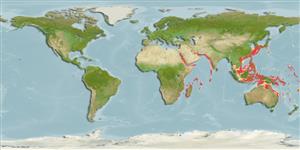Teleostei (teleosts) >
Ophidiiformes (Cusk eels) >
Bythitidae (Livebearing brotulas)
Etymology: Grammonus: Greek, gramma = signal, mark + Greek, onos = hake.
More on authors: Smith & Radcliffe.
Environment: milieu / climate zone / depth range / distribution range
Ecology
Marine; bathydemersal; depth range 45 - 345 m (Ref. 34024). Deep-water
Indo-West Pacific: Red Sea, Japan, East China Sea, and the Philippines.
Size / Weight / Age
Maturity: Lm ? range ? - ? cm
Max length : 21.0 cm SL male/unsexed; (Ref. 559)
Uncommon species found on soft bottom (Ref. 34024). Ref. 9942 gives maximum depth to be 1,260 m.
Life cycle and mating behavior
Maturity | Reproduction | Spawning | Eggs | Fecundity | Larvae
Nielsen, J.G., D.M. Cohen, D.F. Markle and C.R. Robins, 1999. Ophidiiform fishes of the world (Order Ophidiiformes). An annotated and illustrated catalogue of pearlfishes, cusk-eels, brotulas and other ophidiiform fishes known to date. FAO Fish. Synop. 125(18):178p. Rome: FAO. (Ref. 34024)
IUCN Red List Status (Ref. 130435: Version 2024-1)
Threat to humans
Harmless
Human uses
Fisheries: of no interest
Tools
Special reports
Download XML
Internet sources
Estimates based on models
Preferred temperature (Ref.
123201): 12.9 - 26.5, mean 19.5 °C (based on 337 cells).
Phylogenetic diversity index (Ref.
82804): PD
50 = 0.5005 [Uniqueness, from 0.5 = low to 2.0 = high].
Bayesian length-weight: a=0.00447 (0.00172 - 0.01163), b=3.10 (2.87 - 3.33), in cm total length, based on LWR estimates for this (Sub)family-body shape (Ref.
93245).
Trophic level (Ref.
69278): 3.6 ±0.5 se; based on size and trophs of closest relatives
Resilience (Ref.
120179): Medium, minimum population doubling time 1.4 - 4.4 years (Preliminary K or Fecundity.).
Fishing Vulnerability (Ref.
59153): Low vulnerability (16 of 100).
